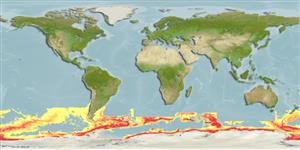Pycnogonida |
Pantopoda |
Nymphonidae
Environment: milieu / climate zone / пределы глубины / distribution range
экология
; пределы глубины 0 - 4136 m (ссылка 1680). Polar
Southeast Pacific, Western Atlantic, and Antarctic.
Length at first maturity / Size / Weight / Возраст
половая зрелость: Lm ? range ? - ? cm
Leg span: 2 - 3 cm, a tall ocular tubercle with prominent eyes, and closely crowded lateral processes which usually, along with the trunk, have long dorsal spines. Spines are also carried on the chelifore scape and in rows along the leg. It has a short neck, crowded with a bulbous oviger base on each side. The male ovigers have distally inflated fifth and sixth segments which are often collapsed. The tarsus, with strong distal spines, is usually as long as or longer than the propodus which has a short main claw and vestigial or missing auxiliary claws. A wide range of variations occur among the many specimens of this species. This is attested to by its several synonyms. This is the genotype of a group of 20 predominantly Antarctic species which belong to a discrete assemblage called the australe group (Ref. 156). It shares the diagnostic characters enumerated above with the others and forms one of the groups into which this cumbersome genus must be divided if any sense is to be made of trying to separate its multitude of species (Ref. 9).
Maximum depth from Ref. 87394. Found to have hydroid colonies grasped in its chelifores (Ref. 121217).
Life cycle and mating behavior
половая зрелость | размножение | нерест | Eggs | Fecundity | Larvae
Members of the class Pycnogonida are gonochoric and sexually dimorphic. During copulation, male usually suspends itself beneath the female. Fertilization occurs as the eggs leave the female's ovigers. Males brood the egg masses until they hatch. Life cycle: Eggs hatch into protonymphon larva then to adults.
Основная ссылка
ссылки | координатор | соавторы
Child, C.A. 1998 The marine fauna of New Zealand: Pycnogonida (sea spiders). NIWA Biodiversity Memoire 109. National Institute of Water and Atmospheric Research (NIWA). Washington, D.C. 20530, USA. 71 p. + Figure 2A-G, 3A-F, 4, 5. (ссылка 9)
Статус Красного Списка МСОП
(ссылка 130435: Version 2025-1)
Статус СИТЕС (ссылка 108899)
Not Evaluated
CMS (ссылка 116361)
Not Evaluated
Угроза для людей
Использование человеком
| FishSource |
инструменты
дополнительная информация
Trophic EcologyFood items (preys)
состав пищи
потребление пищи
хищники
Population dynamicsрост
Max. ages / sizes
Length-weight rel.
Length-length rel.
Размерный состав
Mass conversion
численность
Life cycleразмножениеполовая зрелостьFecundityнерестEggsРазвитие икрыLarvae PhysiologyOxygen consumption
Human RelatedStamps, coins, misc.
ресурсы в Интернет
Estimates based on models
Preferred temperature
(Ref.
115969): -1.9 - 2.1, mean 0.6 (based on 1187 cells).
Категория цены
Unknown.
